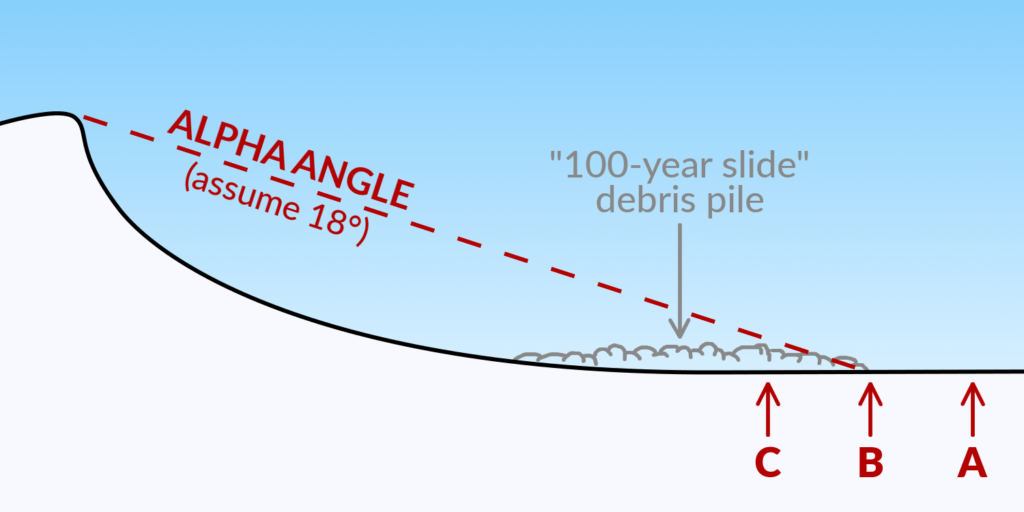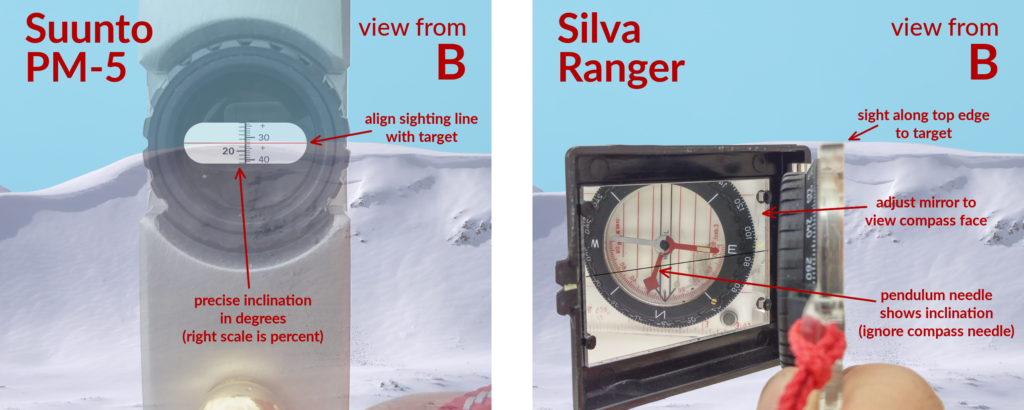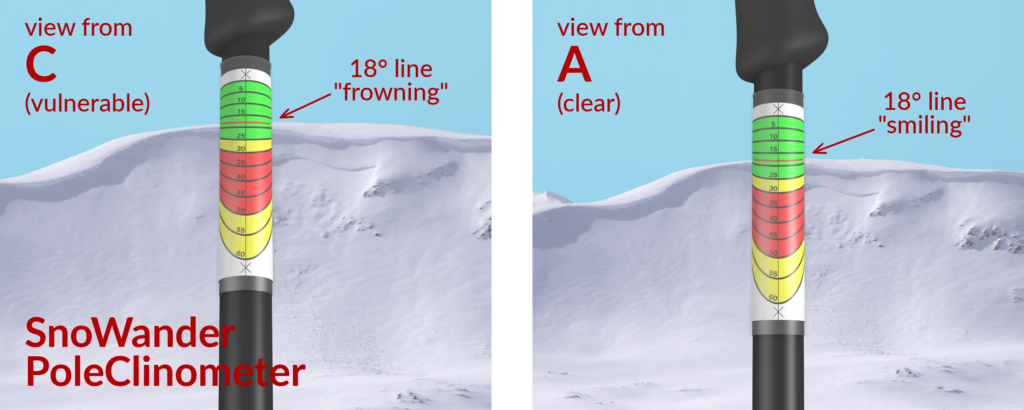Alpha Angle for Backcountry Skiers
The concept of “alpha angle”, aka “runout angle”, can help you identify if you’re a safe distance from a potential avalanche path. Basically, alpha angle is the incline of an imaginary line drawn between the start zone of a slide (its crown, or highest point) and the farthest toe of the resulting debris field. Alpha angles for “100 year” avalanches (i.e. the big ones) are typically in the 18° to 20° range, depending on the specific mountain range and other factors. Unless you have site-specific data showing otherwise, assuming a slide will go no farther than 18° in runout is generally the safe bet.
How many times have you asked yourself: “am I far enough from that slope to be safe if it lets go?” In the above illustration, it’s easy to see that you’re much better off in position “A” than in position “C” if the slope were to slide. But how do you know where you are in relation to alpha angle? Use an inclinometer!
Inclinometers for Alpha Angle
An inclinometer (aka clinometer or slope meter) is a device for measuring angles relative to horizontal. In backcountry skiing, inclinometers are commonly used to measure slope angle. Alpha angle is something different, and not all models of inclinometer support the line-of-sight measurement mode required for gauging alpha angle. Inclinometer phone apps in particular, while handy in some other use modes, do not tend to work well for this type of line-of-sight measurement. A couple example devices that do work well for alpha angle measurements are the excellent (if pricey) Suunto PM-5 clinometer, and many mirror-equipped compasses with built-in clinometer feature, such as the Silva Ranger or Suunto MC-2 series. Here’s what these look like when sighting for alpha angle (from point “B” in the above diagram):
In both cases, your sighting “target” is the highest possible start zone of the suspect avalanche path. If you measure greater than 18° inclination to that point, then you could be in the firing line if a big slide lets go. If less than 18°, then you can be pretty confident you’re clear of even the biggest slide from that particular slope.
PoleClinometer: The “Quick Draw” Option
A newer product in the inclinometer world is the versatile and light-weight PoleClinometer ski pole inclinometer sticker kit. It’s little more than a sticker you put on your ski pole, but it allows incredibly quick (because it’s always in your hand), and surprisingly accurate, inclination measurements. New for the 2016/2017 season is a dedicated alpha angle feature. Here’s how it works (viewed from points “C” and “A” in the top diagram):
When sighting up toward the top of a suspect slope, a red “18° line” indicates if you’re closer or farther than 18° from your sighting target. Reading the red line is easy: If it’s “frowning” (i.e. curved down) you’re closer than 18° and could be vulnerable to a big slide. If it’s “smiling” (i.e. curved up) you’re farther than 18° and should be clear of any slide from that slope.
Applying Alpha Angle
Regardless of your chosen tool for measuring inclination, it’s important to recognize the difference between alpha angle and slope angle measurements from the perspective of traveling safely in the mountains. Slope angle can help tell you “could this slope slide?” Alpha angle can help tell you “am I far enough from that slope to be safe if it does slide?” Here are a couple examples of how you might apply it:
Say avalanche danger is “considerable” with remote triggers likely, and you’re sticking to very safe terrain, but you have to cross some flats below a steep face, with no vegetation to tell you where you’re safe. You can take inclinometer readings along the way to be sure you’re never closer than 18° to the top of the suspect slope, and adjust your course if you start to get too close.
Or say you’ve just skied out to set up camp in a remote alpine amphitheater for a few days, surrounded by juicy couloirs and steep faces. You might take inclination measurements to the tops of surrounding slopes to be sure all are well below 18° from your location before you pitch camp.
Just Another Tool
Obviously, alpha angle is not going to tell you everything you need to know to stay safe in the mountains. But it’s certainly a useful tool to add to your quiver. It’s well worth having an inclinometer (or two) that you trust when you venture into avalanche terrain. Stay tuned for a follow-on article with more on inclinometers for backcountry skiing. And of course keep up your avalanche skills training to better incorporate all your tools for traveling safely in the mountains.
More on Alpha Angle
If you’d like more insights on the use of alpha angle in backcountry skiing, Lou Dawson offers an in-depth discussion in this WildSnow article:
Alpha Angle — How Far Can that Avalanche Go?
And Bruce Tremper has a section on runout angle in his excellent book:
Staying Alive in Avalanche Terrain


